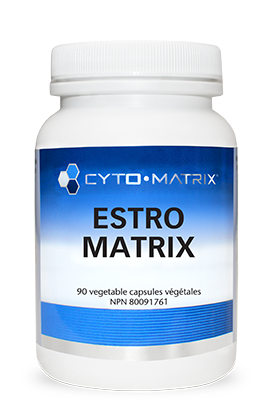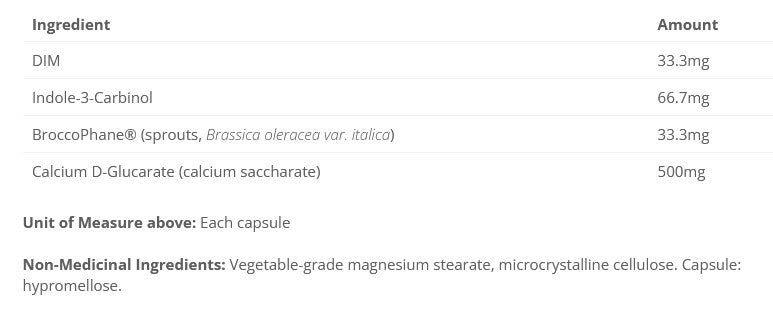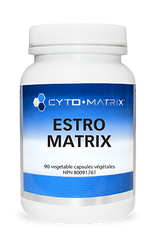



Description
x- Indicated for proper estrogen metabolism, symptomatic control of estrogen-dominated health conditions, and healthy cellular differentiation of breast and cervical tissues, through enhanced xenobiotic detoxification and sustained liver function
- Calcium-D-glucarate acts as a beta-glucoronidase inhibitor to prevent enterohepatic recirculation of estrogens I-3-C and DIM promote the production of 2-OHE1, the protective form of estrogen which acts as an estrogen antagonist in the body
- Sulforaphane glucosinolate potently upregulates phase 2 detoxification enzymes and promotes the elimination of xenobiotics and various carcinogens
The human body is designed with complex detoxification systems to eliminate unnecessary compounds such as food waste byproducts, physically inert metals, and everyday chemicals. However, our detoxification systems are also necessary to regulate steroid hormones such as estrogen. Suboptimal liver and digestive function, coupled with excessive exposure to xenoestrogens, can lead to enterohepatic recirculation of estrogens and ultimately create an estrogen-dominated state with negative implications for the body's health. Fortunately, a number of natural compounds have been identified to support proper estrogen detoxification and healthy hormone metabolism.
Indole-3-carbinol (I-3-C) is naturally found in cruciferous vegetables such as broccoli and cauliflower and is well known for its ability to support healthy estrogen metabolism. I-3-C upregulates the production of 2-OHE1, the protective form of estrogen that acts as an estrogen antagonist. 16-OHE1, on the other hand, has potent estrogenic and proliferative effects that antagonize the action of 2-OHE1. Research has repeatedly shown that a higher ratio of 2-OHE1 to 16-OHE1 is protective against disease and desirable for improving symptoms in estrogen-dominant conditions. I-3-C improves this ratio of estrogen metabolites.
Numerous trials have shown that this positive change in estrogen metabolites, following I-3-C supplementation, is beneficial for health outcomes. For example, I-3-C has been shown to improve estrogen levels and health outcomes in women with cervical disease. Animal studies have also shown that I-3-C can prevent unhealthy cell differentiation in breast tissue. Not only does I-3-C promote a positive estrogen metabolite ratio, but it also influences the expression of several genes, such as the tumor suppressor gene p53 and BRCA1, which collectively support healthy differentiation of hormone-responsive tissues.
I-3-C is naturally metabolized in the body to provide multiple active compounds, including the predominant metabolite diindolylmethane (DIM). Although there is debate as to whether DIM or I-3-C are most beneficial as a health supplement, each compound has its benefits. I-3-C provides the body with many active metabolites, while DIM appears to be a primary metabolite with potent detoxification activity. Both compounds are well-researched and effective treatments for the proper regulation of estrogen in the body.
D-glucarate, or glucaric acid, is another compound found naturally in oranges, carrots, apples and broccoli, and it supports the detoxification of excess hormones, various toxins and carcinogens by deactivating B-glucoronidase. B-glucoronidase is an enzyme produced by the colonic microflora that can “reactivate” compounds previously neutralized by the liver, preventing the recirculation of these toxins in the body. Animal studies have shown that high doses of calcium-D-glucarate can reduce blood estrogen levels by up to 23% and also have a favorable impact on lipid balance. Quite simply, calcium-D-glucarate is one of the most well-known natural B-glucoronidase inhibitors and the best-studied form for safely delivering D-glucarate.
Finally, sulforaphane glucosinolate (SGS) is a natural compound that, like I-3-C and DIM, is also found in broccoli and cruciferous vegetables. Numerous clinical trials support its use in promoting healthy cellular differentiation through the elimination of xenobiotics and potent induction of phase 2 detoxification enzymes in the liver. For example, SGS has been shown to reduce the carcinogenic effects of aflatoxin exposure on liver tissues. SGS also has anti-inflammatory actions through inhibition of nuclear factor kappaB (NFkB), prostaglandin E2, and tumor necrosis factor alpha (TNF-a), it can reduce the expression of estrogen receptors in breast tissue, and it has antimicrobial activity against pathogens such as H. pylori, S. pyogenes, and S. aureus.
At three capsules per day, Cyto-Matrix Estro contains 200 mg of I-3-C, 100 mg of DIM, 1500 mg of calcium-D-glucarate and 100 mg of sulforaphane. Collectively, Estro Matrix provides evidence-based dosages of synergistic ingredients to deliver targeted, ongoing hormonal support through proper estrogen metabolism.
Posologie
xInfos nutritionnelles
x- Choosing a selection results in a full page refresh.

